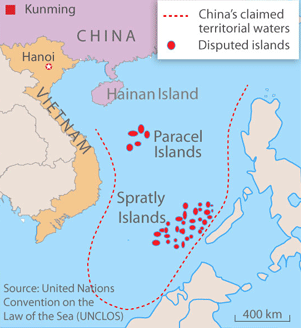Under the shadow of the People’s Republic of China, the countries of Southeast Asia are striving to survive. Devastated by the effects of war, Communism, and economic collapse, these countries must adapt to the growing power in the north. Radical Islamists flock to the Muslim sections of this region in hopes of recruiting youth to their cause, and with a variety of languages, cultures, religions, and resources, these countries are targets for international attention.
As a whole, Southeast Asia is economically rising from the Asian Financial Crisis. Many nations are doing so well that the social and political structures are not able to keep up with the speed of economics, leading to income inequality and lack of rights. China wants to add their currency, the yuan, to the International Monetary Fund, but the Western countries are divided in their support for this. Human trafficking in the region is also common, as are child labor and prostitution. Each country in Southeast Asia needs domestic investment to retain the economic growth. Investors are predicting that credit bubbles exist in Thailand and China and may collapse in the near future.
China is now playing the territorial game in the East and South China Seas. It has aggressively claimed hundreds of miles of ocean in this area and has threatened to defend it. Its island-building violates international law, but it claims that it is acting within its sovereign rights. China’s island-building in the South China Sea is strategically occurring near the Spratly Islands, between Vietnam and the Philippines. The Straits of Malacca, which run through this region, transport a quarter of the world’s shipping trade and oil every year. China claims to be utilizing this island-building to benefit search-and-rescue efforts and weather forecasting, and deny that they are using it as a military base. Countries that are friendly with the U.S. are asking for assistance in removing the Chinese presence. The Filipino people are already experiencing negative effects caused by Chinese infiltration into their maritime territory. Chinese vessels are prohibiting Filipino fishermen from harvesting from their usual locations. The fishing grounds that are not overstepped by China are being destroyed because of coral reef degradation. Food deliveries from the Filipino Air Force are being deterred, depriving Filipinos of their nutritional necessities. This lack of nutrients will potentially affect children’s ability to perform in school, making them more vulnerable to recruitment into violent organizations like ISIS. The Philippines also partook in naval exercises with the U.S. and Japan near the South China Sea, against China’s wishes
Furthermore, China has an estimated 3,000 miles of tunnels, known as China’s “Underground Great Wall,” capable of withstanding nuclear attacks. Concerns of the Underground Great Wall, anti-ship ballistic missiles, and the military’s potential are worrying to Western minds. Many of the top leaders in the Chinese Communist Party were replaced in the 2012 elections, and the government is beginning to show slightly aggressive political tendencies. U.S. friendly countries, such as Taiwan and Vietnam, are feeling threatened and may succumb to the influence of their Chinese neighbor.


